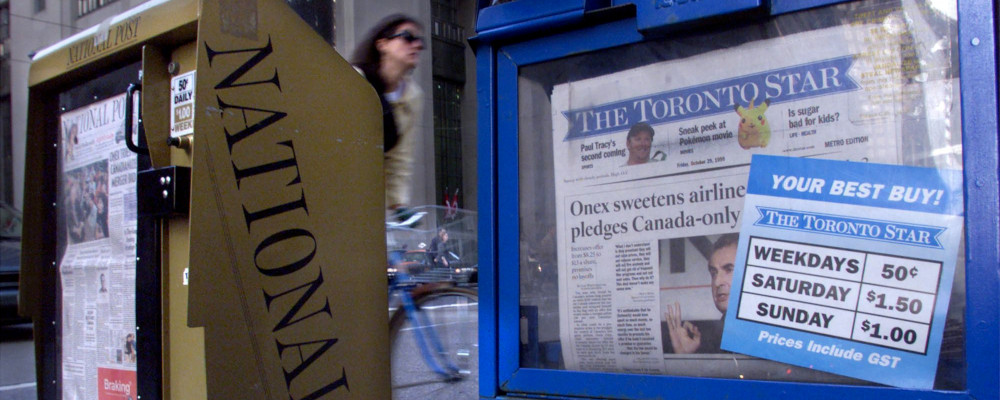The news media in Canada is in crisis. Policy responses to date are failing to solve for the information that citizens need to make informed decisions about important issues and debates. The Future of News series brings together leading practitioners, scholars, and thinkers to imagine new business models, policy responses, and journalistic content that can support a dynamic future for news in Canada.
Twenty years ago, it should have been obvious to all that the jig was up for newspapers and journalism was going to need a new ride.
Print had a good run—almost 600 years—but the invention by Tim Berners-Lee of the World Wide Web meant the era of massive presses and the power they bestowed on their owners was coming to an end. The only question, once Craigslist and Kijiji began boring holes in classified advertising, the economic foundation of newspapers, was whether there would even be time to save the furniture.
Since the turn of the century, there have only been two alternatives for legacy news organizations: adapt or die. While there has been some evidence of success in terms of the former, public policy support has ignored new ideas in favour of propping up the ones everyone knows won’t make it. The results have ranged from inconsequential to catastrophic.
In Canada, as author and academic Marc Edge has detailed in his most recent book, The Postmedia Effect, the possibilities for newspapers to adapt have been severely limited by the nation’s largest and dominant chain’s business and ownership structures. Thousands of jobs have been cut to ensure high-interest debt payments can be made to its U.S. hedge fund owners.
Easy to blame management, one supposes, but hedge funds gotta hedge and the primary fault for the mess that is Canada’s news industry belongs squarely at the door of the nation’s public policymakers. Sadly, outdated foreign ownership regulations restricted the supply of qualified buyers for media organizations, which depressed the cost of acquiring newspapers to a level that facilitated their acquisition en masse by Southam, then Hollinger, then Canwest, then Postmedia. With every step, competition was suppressed through increasingly consolidated ownership only to find the nation’s largest newspaper chain owned by Americans.
You can’t make that up.
Piling on, the Competition Bureau in 2015 inexplicably approved Postmedia’s acquisition of Quebecor (Sun) Media’s newspapers based on the “lack of close rivalry” between newspapers such as the Calgary Herald and the Calgary Sun and “the incentive for the merged entity to retain readership and maintain editorial quality in order to continue to attract advertisers.”
All said with a straight face.
Anyone who had actually worked in the business—I put in shifts at both the Calgary Sun and the Calgary Herald in their halcyon days—would know that this is sheer nonsense justified only by the extreme narrowness of the analysis the Bureau undertook. Today, the only distinguishable difference in content between the Herald and the Sun is that Don Braid writes a column for the Herald, and Rick Bell writes one for the Sun—a pretense of competition that appears to have allowed both to extend their careers well beyond those of thousands of their colleagues.
“No solutions can be found until the issue of the CBC is dealt with.”
Thirty years ago, Bell and Braid shared more than 250 newsroom colleagues covering events in a city of fewer than 800,000 people. Today, reflective of their business’s demise, a couple of dozen survivors cling to the Herald/Sun lifeboat in a city approaching 1.5 million. Their presses and even their buildings have been sold to feed the hedge fund.
Implementation of policies designed to sustain business models that produce results such as these in the hope of “saving journalism” is self-evidently unwise.
We live at a time when innovation and entrepreneurship—virtues that are fuelled by competition and suppressed by consolidation—are desperately needed.
While those are clearly lacking in the newspaper industry (laudable exceptions apply at the Globe and Mail, Le Devoir, and a plethora of digital startups) it’s just as unlikely journalism can find salvation in the arms of Canada’s heavily regulated broadcasting industry. For it, with exceptions acknowledged, the provision of news has always been primarily a regulatory obligation and not a core business proposition.
Broadcasters are in the business of entertaining people with music, drama, chat, and related programming and have long acknowledged there is little or no money in them for news. All too often, it’s just regulatory rent.
For those who may believe, though, the ponderous regulatory processes in place at the Canadian Radio-television and Telecommunications Commission (CRTC) make the entrepreneurship and innovation needed to adapt in an era of massive technological change almost impossible.
But all that is now as may be. Rear view mirrors may help protect from encroaching harms but they are not at all useful in terms of actually going places. And journalism clearly needs a new car and new drivers if it is to thrive as a public good.
Any doubt that societies require trustworthy and shared sources of information to maintain a peaceful social compact should have been erased by the events of the past few weeks.
It is clear from the protests and virulent antisemitism that erupted in the wake of the Hamas attack on Israel that large numbers of Canadians are forming their opinions based not on differing interpretations of the facts but on very incompatible understandings of current reality.
In these circumstances, and in this instance at least, the common ground necessary to establish a healthy public square of ideas simply doesn’t exist. Without such a venue, societies collapse into warring tribes.
But before we can even begin to explore the complexity of THAT problem, there needs to be a sustainable path forward for fair, balanced, and accurate news gathering and delivery.
The federal government’s best efforts to make that happen have been disastrous. The Online News Act has done more harm than good, with news providers losing access to audiences through Facebook and Instagram while an even more disastrous Google news boycott hovers menacingly over the industry. The five-year-old journalism labour tax credit hasn’t stopped newsrooms from continuing to shrink. And while the Local Journalism Initiative has created temporary employment opportunities in news “deserts”, it didn’t stop the Alaska Highway News, as just one example, from folding last month.
Worse, there is increasing evidence to suggest that the more the public becomes aware of direct government funding to journalism organizations, the less likely it is to trust those organizations and label reporters as toadies with labels such as “#JustinJournos.” Should the government change, they would no doubt be #Pierre’sPravda.
None of this ends well.
What Canada desperately needs instead is a multi-pronged, coordinated national strategy based on current economic and market realities that will allow journalism to flourish again. A few months ago, Konrad von Finckenstein and I tried to get the ideas rolling with our policy paper for the Macdonald Laurier Institute, “And Now, The News”.
Its two flashiest recommendations called for the establishment of a truly independent journalism sustainability fund supported by contributions from web giants such as Meta, Google, and others and, vitally, the de-commercialization of the CBC.
The CBC, already government-funded, would not be eligible to draw from this fund, which we proposed should be supported by reasonable levies on tech companies and would only be available to companies whose primary business is the production of news.
I have some sympathy for those who would argue that such a fund would best be used to support entrepreneurship as opposed to simply propping up what commentator Jen Gerson has labelled “zombie” newspapers that refuse to either adapt or die.
But our proposal would nevertheless eschew such distinctions and make the fund accessible to all industry-verified news organizations solely on a per capita/journalist basis. News providers would still be free to make deals with social media to build readership and make other commercial deals with digital platforms as both parties see fit.
But that, on its own, doesn’t solve the problem.
In fact, no solutions can be found until the issue of the CBC is dealt with.
It is one thing to have a public broadcaster. But today’s CBC is not that. It has evolved into a publicly funded commercial broadcaster and online content provider. Even its radio content, while broadcast free of advertising over the air, is repurposed to build online audiences and revenue in direct competition with news startups and legacy media attempting to transition into vibrant digital platforms.
No industry can survive, let alone prosper, when the government subsidizes one commercial entity—in this case with $1.2 billion annually—to the detriment of all others.
There certainly can be an important role for a national, truly public news provider. But CBC must be de-commercialized everywhere it operates, its mandate sharply re-focused, and its content made available at no charge through a Creative Commons license to other domestic news organizations.
The removal of the CBC’s ability to sell advertising would immediately free up $400 million in revenue for which news organizations could compete. As an added benefit, Canada would get a re-focused public broadcaster, and free access to its news content would allow all journalism providers to benefit from, instead of being punished by, government funding of the CBC.

Our other proposals include making subscriptions to news organizations 100 percent tax deductible—a move that would subsidize the consumption of credible news with a market-based incentive for those providing it.
We also proposed that:
- All expenditures by Eligible News Businesses that involve investment in digital transformation technology are eligible to be claimed in their first year as capital cost allowances.
- Phasing out of the current labour tax credit over a period of five years, declining in value by 20 percent annually in order to wean news organizations from it gradually while they adapt to a more permanent policy framework.
- Phasing out of the Local Journalism Initiative over a period of five years, declining in value by $4 million per year and with adjustments that would make it available only to news organizations serving market areas of less than 100,000 people and limited to easily defined core coverage beats such as public safety, courts, school boards, and municipal councils.
- Phasing out of the Canada Periodical Fund, which is no longer relevant in the digital age, over the course of three years.
- Ensure that the CRTC is engaged in the development of national news policies so that it considers the entire scope of the news industry when contemplating conditions of license for broadcasters.
To those, I would add maximizing the value of tax credits for contributions to news organizations structured as not-for-profit businesses.
Neither I nor my policy paper co-author, who these days is occupied as interim federal ethics commissioner, pretended to have all the solutions.
As we wrote when our paper was published, building a national news industry policy is a tricky business.
What we believed was that the pattern of ad hoc subsidies, willful ignorance of the impact of a commercial CBC, fear of failure, and the ill-conceived Online News Act were nothing but trouble and that a thoughtful, multi-pronged national news industry policy was called for.
It still is.
When it’s done—when all the ideas are out there and the best of them are implemented—news organizations will still only survive through the quality of their work.
Not all companies will, or should, survive and, frankly, some need to get on with their dying and get out of the way of those building a future for journalism.
Fretting over and attempting to preserve the past and its icons is emotionally tempting. But it will not give news organizations the fighting chance they need to transition from unstable business models to those capable of sustaining quality journalism in the years ahead.
We are at the end of the end of an era. It’s time to embrace a new genesis.
The Future of News series is supported by The Hub’s foundation donors and Meta.
Recommended for You

81 percent of Canadians worried about food costs as inflation on groceries hits two-year high

‘There needs to be new approaches to old ideas’: Why open debate is so important for shaping Israel’s future

Here’s how Canadian oil and gas can fuel global emissions reductions

Alberta’s health reforms draw on best practices from world-leading universal systems




